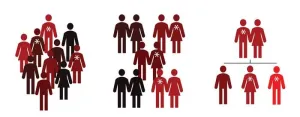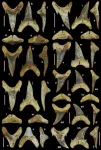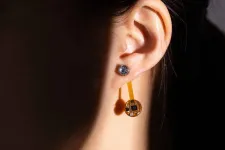(Press-News.org) UNIVERSITY PARK, Pa. — Predicting the trajectory of neurodevelopmental and psychiatric disorders like autism or schizophrenia is difficult because they can be influenced by many different genetic and environmental factors. A new study, led by Penn State researchers, demonstrates that evaluating parents for their manifestation of traits of these disorders — and related diseases like depression and anxiety — may provide a more accurate method of predicting the prevalence, and potentially severity, of the disorders in affected children than screening for genetic variants alone. This is likely due, at least in part, to genetic variants the parents transmit to the child that would not be routinely picked up in a genetic screen and lead to more severe disease, the researchers explained.
A paper describing the research appeared in the American Journal of Human Genetics. According to the researchers, understanding how both parents contribute to their child’s diagnosis could inform genetic counseling and the development of therapeutic intervention plans for children impacted by these disorders.
“We looked at the presence of neurodevelopmental and psychiatric traits in children and parents from a large set of families,” said Santhosh Girirajan, interim department head and T. Ming Chu Professor of Biochemistry and Molecular Biology in the Penn State Eberly College of Science and lead author of the paper. “We saw an increase in the presence of neurodevelopmental disorders in children whose parents both report having the trait, including psychiatric traits like anxiety or depression.”
The team looked at 97,000 families, many including children with neurodevelopmental disorders such as autism or intellectual disability and evaluated how risk factors — genetic features and the presence of the traits — in both parents impact the trajectory of the disease in the children. The datasets included genetic information and questionnaire data from families in a large public biobank, as well as from families from specific studies of neurodevelopmental disorders.
The researchers evaluated parents and their children for symptoms of the various disorders and assessed known genetic mutations that can give rise to such disorders. Their analysis revealed that parents tend to select partners with the same or related disorders, leading to increased prevalence and, potentially, severity of the disorder in their children.
“Most neurodevelopmental disorders are genetically complex, meaning that they aren’t caused by a single gene,” Girirajan said. “This makes it hard to trace the exact genetic underpinnings of a disorder in an individual and even harder to predict how the disorder will play out in affected children.”
The researchers explained that complex genetic diseases can be caused by mutations in many genes, each of which could be inherited from one or both parents, or occur spontaneously in the newly formed genome of the child. The child’s disease prognosis results from the combination of mutations that they inherit and how they interact with one another during development. This is called the “multi-hit model” because the disease results from multiple different mutations in many different genes.
“We have been studying one such mutation — a deletion of a small segment of chromosome 16 — that has been implicated as a risk factor for several neurodevelopmental disorders,” Girirajan said. Symptoms of these disorders can manifest as seizures, schizophrenic features, depression and anxiety, along with characteristics related to addiction. “This mutation is often passed from a parent to a child, but the child regularly has more severe symptoms of the disorder than the parent. We wanted to know if other ‘hits’ for the disorder could be coming from the other parent. So, we looked at the traits of both parents in a large cohort of families with children with neurodevelopmental disorders.”
The research team found that the parent that had passed on the deletion had less severe symptoms than their child or even different but related psychiatric disorders like depression or anxiety. They also found that the other parent often had similar psychiatric traits.
“What we realized, and it’s been studied for a long time, is that in people there is a phenomenon called ‘assortative mating,’” said Corrine Smolen, a graduate student at Penn State working with Girirajan and the first author of the paper. “Whether it’s consciously or unconsciously, people with similar features preferentially find each other as partners. Although there could be other explanations, we see this in our data and that is probably what is leading to what we are seeing in the families that we studied.”
The parent that doesn’t have the deletion must have these traits because of some other genetic mutations, the researchers explained, and when these mutations are combined with the deletion in the genome of the child, the result is more severe disease. By assessing the traits in both parents, the researchers could more accurately predict the trajectory of the disease in their children than would be possible via genetic screening alone. They also could eventually use this information to try to identify new mutations — those inherited from the parent without the deletion — that are involved in causing these traits.
“We found that there is a good correlation between the traits in the parents,” Girirajan said. “Someone with schizophrenia is more likely to find a partner with schizophrenia, someone with anxiety and depression is more likely to find a partner with anxiety and depression. This is well-known for other things, like tall people marrying other tall people. Because all of these traits have at least some genetic component that could be similar between the partners, this leads to a situation that is akin, but less pronounced, to consanguineous marriage, when people who are related through ancestry marry.”
In this case, Girirajan explained, the assortative mating based on traits — rather than relatedness — appears to be driving genetic similarity between the partners which could be leading to more cases and potentially more severe traits in their offspring. As an example, the researchers saw that when neither partner had anxiety, 12.6% of their male children had anxiety. That number jumped to 25.7% when one parent reported having anxiety and to 33.8% when both parents had anxiety. This increase in prevalence is indicative of an increase in severity because more severe traits are more likely to be identified, according to the research team.
In addition to Girirajan and Smolen, the research team includes Matthew Jensen, Lucilla Pizzo, Anastasia Tyryshkina, Deepro Banerjee, Laura Rohan and Emily Huber at Penn State; Lisa Dyer and Jane Juusola at GeneDx, in Maryland; Laila El Khattabi at the Assistance Publique–Hôpitaux de Paris in France; Paolo Prontera at the Santa Maria della Misericordia Hospital in Italy; Jean-Hubert Caberg at the Centre Hospitalier Universitaire de Liège in Belgium; Anke Van Dijck and R. Frank Kooy at the University and University Hospital Antwerp in Belgium; Charles Schwartz at the Greenwood Genetic Center in South Carolina; Laurence Faivre, Patrick Callier, and Mathilde Lefebvre at the Université de Bourgogne Franche Comté in France; Anne-Laure Mosca-Boidron at the Laboratoire de Genetique Chromosomique et Moleculaire in France; Kate Pope, Penny Snell and Paul J. Lockhart at the University of Melbourne in Australia; David J. Amor at the Murdoch Children's Research Institute in Australia; Lucia Castiglia, Ornella Galesi, Emanuela Avola and Maria Grazia Bruccheri at the Oasi Research Institute in Italy; Teresa Mattina, Marco Fichera and Corrado Romano at the University of Catania in Italy; Giuseppa Maria Luana Mandarà at ASP Ragusa in Italy; Olivier Pichon, Silvestre Cuinat, Sandra Mercier, Claire Bénéteau and Bertrand Isidor at CHU Nantes in France; Cedric Le Caignec at the Université de Toulouse in France; Radka Stoeva at CHU de Le Mans in France; Sophie Blesson and Dominique Martin-Coignard at Bretonneau University Hospital in France; Ashley Nordsletten at the University of Michigan; and Erik Sistermans at Amsterdam UMC in the Netherlands.
Grants from the U.S. National Institutes of Health, the South Carolina Department of Disabilities and Special Needs, and the Italian Ministry of Health-Ricerca Corrente supported the research.
END
Predicting neurodevelopmental disease in children from parent’s traits
2024-02-07
ELSE PRESS RELEASES FROM THIS DATE:
New species of 65 million year old fossil shark discovered in Alabama, USA
2024-02-07
Birmingham, AL (February 7, 2024) – Today, a team of scientists is pleased to announce the discovery of a new fossil shark species from Alabama, USA. The team is led by Jun Ebersole, Director of Collections, McWane Science Center, Birmingham, AL, David Cicimurri, Curator of Natural History, South Carolina State Museum in Columbia, and T. Lynn Harrell, Jr., Paleontologist and Fossil Collections Curator at the Geological Survey of Alabama in Tuscaloosa.
The shark is a new species of Palaeohypotodus (pronounced pale-ee-oh-hype-oh-toe-duss), which means “ancient small-eared tooth,” in reference to the small needle-like fangs present on the sides of the teeth. It has ...
Time to treatment with intravenous thrombolysis before thrombectomy and functional outcomes in acute ischemic stroke
2024-02-07
About The Study: In patients presenting at thrombectomy-capable stroke centers, the benefit associated with intravenous thrombolysis (IVT) plus thrombectomy versus thrombectomy alone was time dependent and statistically significant only if the time from symptom onset to expected administration of IVT was short in this individual participant data meta-analysis (n = 2,313) of six randomized clinical trials.
Authors: Johannes Kaesmacher, M.D., Ph.D., of the University of Bern in Bern, Switzerland, is the corresponding author.
To access the embargoed study: Visit ...
Many hookah manufacturers have not complied with FDA-mandated nicotine warning labels
2024-02-07
FOR IMMEDIATE RELEASE
February 7, 2024
Contact:
Jillian McKoy, jpmckoy@bu.edu
Michael Saunders, msaunder@bu.edu
##
Many Hookah Manufacturers Have Not Complied with FDA-Mandated Nicotine Warning Labels
Only half of the hookah packages assessed in a new study included the required nicotine warnings, two years after this federal regulation was implemented to alert consumers about the health risks of nicotine addiction.
Since August 2018, the US Food & Drug Administration has mandated that all hookah (also known as waterpipe tobacco or shisha) manufacturers include a nicotine warning ...
Endovascular thrombectomy for large ischemic stroke across ischemic injury and penumbra profiles
2024-02-07
About The Study: In this exploratory analysis of a randomized clinical trial of 336 patients with extensive ischemic stroke, endovascular thrombectomy (EVT) improved clinical outcomes across a wide spectrum of infarct volumes, although enrollment of patients with minimal penumbra volume was low. In EVT-treated patients, clinical outcomes worsened as presenting ischemic injury estimates increased.
Authors: Amrou Sarraj, M.D., of University Hospital Cleveland Medical Center—Case Western ...
Apixaban to prevent recurrence after cryptogenic stroke in patients with atrial cardiopathy
2024-02-07
About The Study: In patients with cryptogenic stroke and evidence of atrial cardiopathy without atrial fibrillation, oral anticoagulant therapy with apixaban did not significantly reduce recurrent stroke risk compared with aspirin in this randomized clinical trial that included 1,015 participants.
Authors: Hooman Kamel, M.D., of Weill Cornell Medicine in New York, is the corresponding author.
To access the embargoed study: Visit our For The Media website at this link https://media.jamanetwork.com/
(doi:10.1001/jama.2023.27188)
Editor’s Note: Please see the article for additional information, including other authors, author contributions ...
MD Anderson research highlights for February 7, 2024
2024-02-07
HOUSTON ― The University of Texas MD Anderson Cancer Center’s Research Highlights showcases the latest breakthroughs in cancer care, research and prevention. These advances are made possible through seamless collaboration between MD Anderson’s world-leading clinicians and scientists, bringing discoveries from the lab to the clinic and back.
Recent developments at MD Anderson include a combination treatment for patients with acute myeloid leukemia (AML), the discovery of a molecular driver in metastatic breast cancer, an oral combination therapy for high-risk myelodysplastic syndromes (MDS) and chronic myelomonocytic leukemia (CMML), a novel method to mechanically destroy ...
UW-developed smart earrings can monitor a person’s temperature
2024-02-07
Smart accessories are increasingly common. Rings and watches track vitals, while Ray-Bans now come with cameras and microphones. Wearable tech has even broached brooches. Yet certain accessories have yet to get the smart touch.
University of Washington researchers introduced the Thermal Earring, a wireless wearable that continuously monitors a user’s earlobe temperature. In a study of six users, the earring outperformed a smartwatch at sensing skin temperature during periods of rest. It also showed promise for monitoring signs of stress, eating, exercise and ovulation.
The smart earring prototype is about ...
Quantum simulation with ultracold fermions unveils pairing pseudogap
2024-02-07
A research team led by Professors PAN Jianwei, YAO Xingcan, and CHEN Yu'ao from the University of Science and Technology of China (USTC) of the Chinese Academy of Sciences, have for the first time observed and quantitatively characterized the many-body pairing pseudogap in unitary Fermi gases. This achievement, pursued by the ultracold atomic community for nearly two decades, resolves longstanding debates regarding the existence of a pairing pseudogap in these gases. It also supports ...
New research uncovers biological drivers of heart disease risk
2024-02-07
New gene mapping technique reveals how genetic alterations in cells lining blood vessels contribute to coronary artery disease, with implications for diagnostic and treatment strategies.
KEY TAKEAWAYS
Researchers from the Brigham, the Broad Institute, and Stanford Medicine studied how "deleting" individual genes associated with coronary artery disease (CAD) impacted the expression of all the other genes in a cell to better understand underlying biology of CAD.
The study focused on endothelial cells, which line blood vessels and are increasingly understood to influence CAD risk.
The researchers highlighted a previously unrecognized role for the TLNRD1 gene ...
Resting boosts performance of lithium metal batteries
2024-02-07
Next-generation electric vehicles could run on lithium metal batteries that go 500 to 700 miles on a single charge, twice the range of conventional lithium-ion batteries in EVs today.
But lithium metal technology has serious drawbacks: The battery rapidly loses its capacity to store energy after relatively few cycles of charging and discharging – highly impractical for drivers who expect rechargeable electric cars to operate for years.
Scientists have been testing a variety of new materials and techniques to improve the battery’s cycle life. Now, Stanford University researchers have discovered a low-cost solution: simply drain the battery and let it rest for several hours. ...





